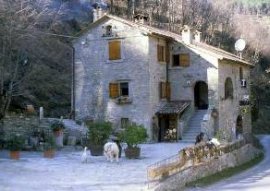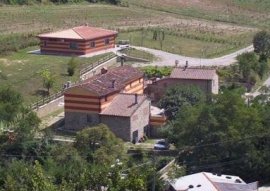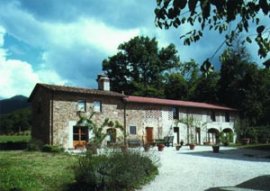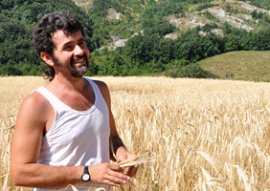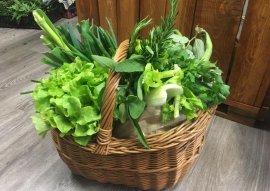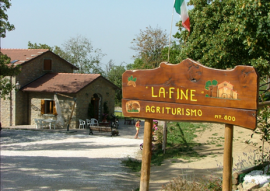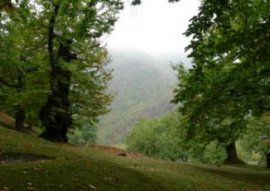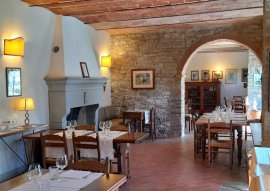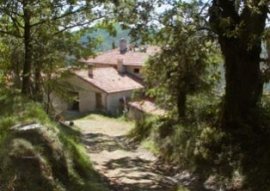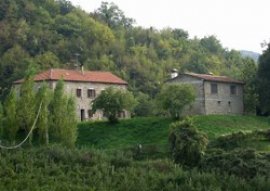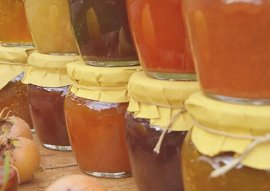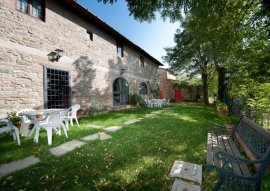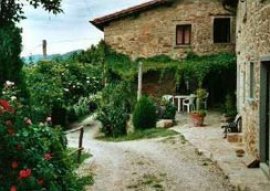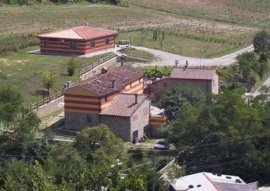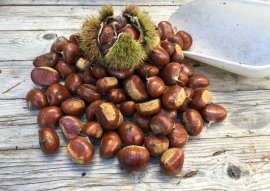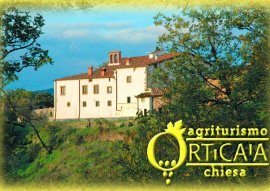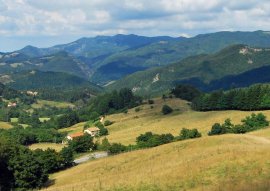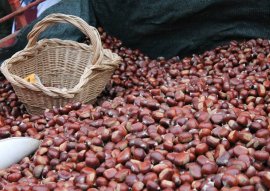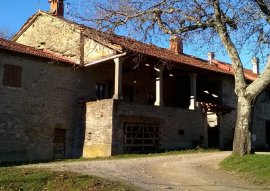The excellent Mugello chestnut, more widely known as the marrone, has been adwarded the IGP (Protected Geographical Identification) standing by accordance with CEE n. 2081/92 regulations.
The characteristics
The Mugello marrone comes from chestnut trees of a specific local variety that can be traced to the Florentine marrone family. The chestnut groves, 3,322 hectares of land, grow on hillsides that are from 300 to 900 metres above sea level, and the maximum density is 120-160 plants per hectare.
The shelled, freshly picked Mugello marrone is characterised by its medium size (no more than 80 chestnuts to a kilo). It has an oval shape, slight point with the presence of a tuft, one flat side and one markedly convex side, and a rectangular shaped, flat and lighter coloured cicatrix at the base. The pericarp (husk), which is easily removed from the episperm, is thin, reddish-brown and streaked with 25-30 slightly darker vertical lines.
The pulp of the nut, usually one per fruit, is white, crunchy and sweet tasting, and has hardly any creases. The “Marron Buono di Marradi”, is the most appreciated and renowned of them all, but other Italian varieties are also quite good, for example: the Carpinese, Fragonese, Cecio, Montanina and Reggiolana.
The history
Chestnut growing in Mugello dates back to Roman times, but it is only from the Medieval period that we find numerous documents and genuine accounts of the diffusion and importance of the groves, and in particular, the marrone. The hundred year old marrone chestnut woods in the area have been providing an important, irreplaceable source of food and revenue for the local population since the end of the 1950’s. The chestnut is, in fact, more commonly known as the “bread tree”. After a 30 year regression, during which we have witnessed a drastic decrease in the mountain population, a change in culinary tendencies, and a notable reduction of chestnut woods due to the advent and growth of cortical cancer, the 1980’s have brought with them renewed interest and the diffusion of this speciality.
Where and how they are produced
The area of production covers a part of the territory in the province of Florence, a part of Mugello, which includes the entire area of Marradi, Palazzuolo sul Senio and Dicomano, and a part of Borgo San Lorenzo, Firenzuola, Londa, Rufina, San Godenzo, Scarperia e San Piero and Vicchio.
The chestnut harvest, as well as the selecting of the chestnuts, is generally done by hand in the months of October and November. They are however, calibrated using a revolving screen.
Neither phito-pharmaceuticals nor fertilizers are used during the production, and no chemicals or additives are used for the preservation. There are, however, ways to preserve the product, for example cold water baths, or first hot and then cold water baths.
After October 5, the product is put on the market in various forms: freshly picked, fresh kept, dried with the shell, dried without the shell, and chestnut flour.
CONTROL AND DEVELOPMENT OF THE MARRONE
"Ministry of Agricultural, Food and Forestry Policies" is in charge of the preservation of the product.
Consorzio Marrone del Mugello IGP was founded in 2007 and aims to promote and diffuse the IGP logo. The Consortius is made up of chestnut producers who have created a control system to guarantee the quality of the product, and to guarantee that production regulations are respected. Its office is by Unione Montana dei Comuni del Mugello, the President is Emanuele Piani consorziomarronemugelloigp@gmail.com - http://ilmarronedelmugello.com
The offices of the "Camera di Commercio" of Florence by "Ufficio Certificazione olio d’oliva e prodotti tipici" (Office for the certification of olive oil and other typical products) tel. 055 2795539/567/507 Volta dei Mercanti, 1 Florence.
ASSOCIATION “Strada del Marrone” (The Marrone-chestnut Route) of Mugello in Marradi
The Association "Strada Del Marrone" in Marradi, can be found at 1 Piazza Scalelle – Marradi, and aims to promote the value of the marrone chestnut.
Tel. 055 8042363 - 328 8127597 Fax 055 8045803 info@stradadelmarrone.it www.stradadelmarrone.it
The association is made up of chestnut farmers that grow and sell the marrone, as well as those who offer tourists a way to acquaint themselves with all the products that derive from the chestnut and the chestnut wood.
IGP Mugello Marrone flour
The characteristics
Chestnut flour is very fine. The colour may vary from pale yellow to beige or yellowish-brown depending on drying techniques. The smoky smell can be more or less perceptible. Once used to produce a mush that replaced bread in the daily diet, today this flour is used to make sweet and salty dishes. In particular, it’s used to make a great variety of sweets, cakes and biscuits.
The history
Chestnut flour, along with freshly picked and fresh kept chestnuts, has been an important part of the diet of the Florentine Apennine mountain folk for centuries. For storage, it was pressed into chests made from the sole trunk of a chestnut tree. The IGP production system is identical to the one used centuries ago and passed down through the ages.
How it is produced
The marrone chestnuts - 90 chestnuts weigh over a kilo – are dried in metati (drying room where the marroni are placed on chestnut wood mats and exposed to moderate heat) using the traditional method. The flour obtained cannot exceed 30% of the weight of the fresh product.
Phone: + 39 055 8045094 - 055 8042587
Website: www.maneggiocasetta.com
Email: info@maneggiocasetta.com
Phone: +39 055 841336 3478185934
Website: www.rimaggiori.com
Email: info@rimaggiori.com
Phone: + 39 055 8490367
Website: www.centrocarnimugello.it
Email: info@centrocarnimugello.it
The Shop is open from Monday to Saturday 8.30am-1pm and 3.30pm-7.30pm, on Sunday 8.30am-12.30am
Phone: +39 055 8407690 - 055 8407671
Mobile: + 39 338 9393049
Website: www.agriturismoilponte.it
Email: rocco_trotta@libero.it
Phone: + 39 055 8401158
Website: www.agriturismosanvitale.it
Email: info@agriturismosanvitale.it
Phone: + 39 055 0763253
Mobile: +39 333 9978977
Website: www.palazzovecchio.eu
Email: info@palazzovecchio.eu
Phone: +39 347 2885260
Email: agriturismobrenzone@virgilio.it
Mobile: +39 333 4734515
Email: gianmarcosoro@gmail.com
Phone: + 39 055 8101017
Email: vivoli.marcello@tiscali.it






































